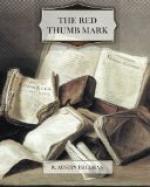“Let them draw ahead,” said he. “It is a wise precaution to give all hooligan gangs a very wide berth at this time of night. We had better turn down Heathcote Street and cross Mecklenburgh Square.”
We continued to walk on at reduced speed until we reached Heathcote Street, into which we turned and so entered Mecklenburgh Square, where we mended our pace once more.
“The hooligan,” pursued Thorndyke, as we walked briskly across the silent square, “covers a multitude of sins, ranging from highway robbery with violence and paid assassination (technically known as ‘bashing’) down to the criminal folly of the philanthropic magistrate, who seems to think that his function in the economy of nature is to secure the survival of the unfittest. There goes a cyclist along Guildford Street. I wonder if that is our strenuous friend from the station. If so, he has slipped past the hooligans.”
We were just entering Doughty Street, and, as Thorndyke spoke, a man on a bicycle was visible for an instant at the crossing of the two streets. When we reached Guildford Street we both looked down the long, lamp-lighted vista, but the cyclist had vanished.
“We had better go straight on into Theobald’s Road,” said Thorndyke, and we accordingly pursued our way up the fine old-world street, from whose tall houses our footfalls echoed, so that we seemed to be accompanied by an invisible multitude, until we reached that part where it unaccountably changes its name and becomes John Street.
“There always seems to me something very pathetic about these old Bloomsbury streets,” said Thorndyke, “with their faded grandeur and dignified seediness. They remind me of some prim and aged gentlewoman in reduced circumstances who—Hallo! What was that?”




